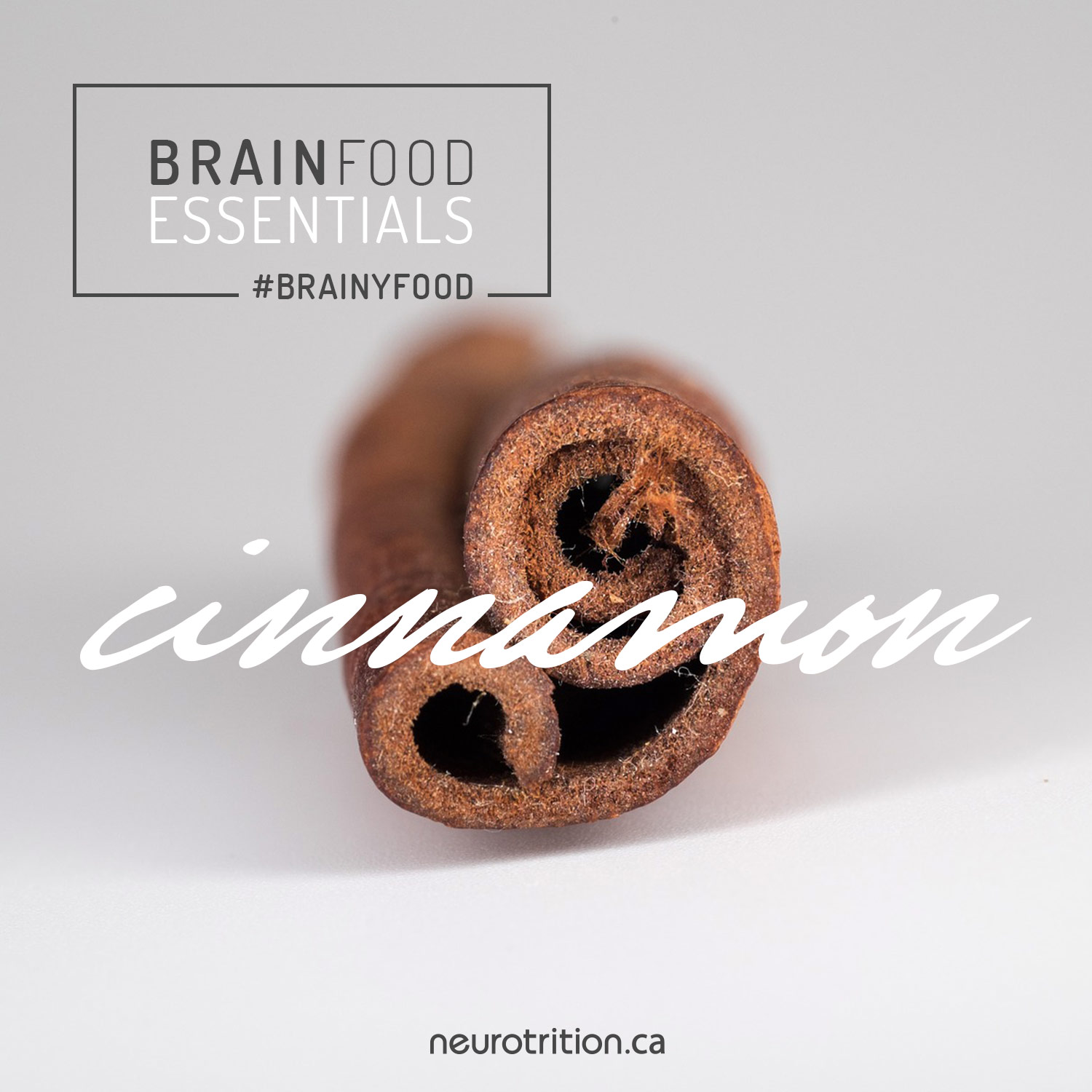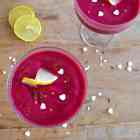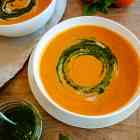Brain Food Essentials: Cinnamon

It’s the delicious spice that everyone loves!
A favourite of bakers everywhere.
And it’s great for your noggin too.
Have you ever thought of cinnamon as brain food?
It is.
Cinnamon has been used for thousands of years as a medicinal spice. It’s filled with phytochemicals (phyto=plant), and has both health benefits and brain benefits.
Cinnamon is an ancient spice that comes from the cinnamomum tree. It’s commonly found dried and ground, or even as “cinnamon sticks,” in the spice aisle of every grocery store.
Let’s go over some of the science behind what makes cinnamon a “brain food essential,” how to choose the highest quality cinnamon, and finish off with some ah-mazing cinnamon recipes created by our very own Neuro-Chefs.
MEDICINAL USES OF CINNAMON
Cinnamon has been used for thousands of years, not only for its fragrance and flavour, but also as a medicine. Some of its historical medicinal uses have been for digestive and respiratory issues.
Cinnamon is originally from Sri Lanka (formerly known as “Ceylon”), and was so highly treasured that it’s part of what inspired Christopher Columbus to set sale in the 15th century. Sadly, controlling the cinnamon supply was so important to some people throughout history, that several wars were even fought over it.
Research has shown that some cinnamon extracts (concentrated solutions) have anti-cancer, heart-protective, anti-microbial, anti-diabetes, anti-inflammatory, and antioxidant properties. Not to mention how it can help your brain!
Yes, cinnamon contains some nutrients, mainly manganese, iron, calcium, and fibre; but it has other health-promoting compounds too.
Cinnamon’s health benefits are thought to be from its many special phytochemicals (healthy plant compounds).
Cinnamon’s health benefits are thought to be from its many special phytochemicals (healthy plant compounds). These compounds include the fat-soluble (dissolve in fats and oils but not in water) cinnamaldehyde and epicatechin, as well as some of its water-soluble compounds (dissolve in water but not in fats and oils).
And they have some pretty brainy benefits.
CINNAMON AS BRAIN FOOD
When it comes to brain health, cinnamon extracts seem to slow down the progression and even improve some symptoms of “neurodegenerative” diseases (that result from a gradual loss of neuron function), like Alzheimer’s and Parkinson’s. At least this has been shown in animal studies.
The two compounds in a fat-soluble cinnamon extract (cinnamaldehyde and epicatechin) seem to help slow down the buildup of a specific and unhealthy Alzheimer’s protein (“tau”) in brain cells.
In laboratory studies for Alzheimer’s, the two compounds in a fat-soluble cinnamon extract (cinnamaldehyde and epicatechin) seem to help slow down the buildup of a specific and unhealthy Alzheimer’s protein (“tau”) in brain cells.
Even more promising, is research that shows that memory and cognition (your ability to think) can be improved after ingesting a cinnamon extract. In some studies, animals that ingested a water-soluble cinnamon extract showed not only a reduced amount of another unhealthy Alzheimer’s protein (“beta-amyloid”) in their brains, but also improved memory and cognition!
In terms of Parkinson’s, ingesting cinnamon has been shown to increase the levels of a certain neuroprotective compound called “sodium benzoate” in rodent brains.
What’s interesting here is that it’s not the cinnamon that directly helps the brain; but when the cinnamaldehyde is metabolized by the liver, that neuroprotective sodium benzoate is created, which can then go through the “blood-brain barrier” to enter the brain. Once there, the compound stimulates other neuroprotective compounds that help protect brain cells from Parkinson’s.
Talk about teamwork, heh?
The cinnamon extract in this Parkinson’s study was also shown to help normalize levels of certain neurotransmitters (chemical messengers that help nerve cells communicate with each other).
The best part is that the Parkinson’s mice that got the cinnamon had improved motor function (ability to move properly), which is the main concern for people with Parkinson’s.
Cinnamon extract is looking pretty brainy right about now, isn’t it?
WHAT TYPE OF CINNAMON IS RECOMMENDED?
When you’re buying cinnamon, not all of it is created equal.
There are two main types of cinnamon; the common type known as “cassia”, as well as the “true” cinnamon known as ceylon.
Cassia cinnamon is the inexpensive and common type that is found in grocery stores. It is from the tree Cinnamomum aromaticum.
True or “ceylon” cinnamon is from the tree Cinnamomum zeylanicum. Ceylon cinnamon tastes a bit sweeter than the cassia type, and is also a bit lighter in colour.
And, yes, “ceylon” cinnamon is harder to find and more expensive than the common type, “cassia”.
Both types seem to have similar health-promoting compounds, but cassia cinnamon contains higher amounts of a substance known as “coumarin”.
High doses of coumarin may be cancer-causing, liver toxic, and “thin” the blood. Of course, harmful doses are very unlikely from regular dietary use of cinnamon, even the common “cassia” type. However, super-high doses, like in some supplements, can be dangerous to certain people with liver or blood-clotting conditions. Always read the product labels and check with your healthcare professional when changing your supplement regimen.
We like to be on the safer (and tastier) side, and recommend that you stick with the true “ceylon” cinnamon!
7 AH-MAZING WAYS TO GET CINNAMON
- Of course, sprinkling some cinnamon on your favourite fruit is so simple, yet so good. Have you tried it on bananas, or apples with nut butter, like one of our recommended snacks in THIS article?
- How about adding it as one of the superfoods in our chocolate pudding recipe, here?
- Or drinking it in your coffee in THIS Neuro-Chef creamer recipe.
- Don’t be shy - try adding some cinnamon to your favourite smoothie recipe.
- Top up your favourite hot breakfast, like oats, quinoa, or rice with a dash or two of cinnamon.
- Or even on top of your favourite cold breakfast like yogurt or chia pudding.
- You may want to enjoy its soothing warmth by steeping a cinnamon stick in hot water to make a delicious tea.
We love brain foods, and that includes spices like cinnamon. Not only is it absolutely delicious, but it’s such an easy way to ramp up the nutrition and neuroprotection that is so important for every day brain health.
- References
-
- Canadian Food Inspection Agency, 2011-2012 Coumarin in Cinnamon and Cinnamon-Containing Products, Accessed February 14, 2017.
- Examine.com, Cinnamon supplements, Accessed February 14, 2017.
- Frydman-Marom, A., Levin, A., Farfara, D., Benromano, T., Scherzer-Attali, R., Peled, S., Vassar, R., Segal, D., Gazit, E., Frenkel, D. & Ovadia. M. (2011). Orally administrated cinnamon extract reduces β-amyloid oligomerization and corrects cognitive impairment in Alzheimer's disease animal models. PLoS One, 6(1):e16564.
- George, R.C., Lew, J. & Graves, D.J. (2013). Interaction of cinnamaldehyde and epicatechin with tau: implications of beneficial effects in modulating Alzheimer's disease pathogenesis. J Alzheimers Dis. 36(1):21-40.
- Health Canada, Natural and Nonprescription Health Products Directorate, Cinnamon Monograph, Accessed February 9, 2017.
- Jana, A., Modi, K.K., Roy, A., Anderson, J.A., van Breemen, R.B. & Pahan, K. (2013). Up-regulation of neurotrophic factors by cinnamon and its metabolite sodium benzoate: therapeutic implications for neurodegenerative disorders. J Neuroimmune Pharmacol. 8(3):739-55.
- Kawatra, P. & Rajagopalan, R. (2015). Cinnamon: Mystic powers of a minute ingredient. Pharmacognosy Res. 7(Suppl 1):S1-6.
- Khasnavis S1, Pahan K. (2014). Cinnamon treatment upregulates neuroprotective proteins Parkin and DJ-1 and protects dopaminergic neurons in a mouse model of Parkinson's disease. J Neuroimmune Pharmacol. 9(4):569-81.
- Malik, J., Munjal, K. & Deshmukh, R. (2015). Attenuating effect of standardized lyophilized Cinnamomum zeylanicum bark extract against streptozotocin-induced experimental dementia of Alzheimer's type. J Basic Clin Physiol Pharmacol. 26(3):275-85.
- Peterson, D.W., George, R.C., Scaramozzino, F., LaPointe, N.E., Anderson, R.A., Graves, D.J. & Lew, J. (2009). Cinnamon extract inhibits tau aggregation associated with Alzheimer's disease in vitro. J Alzheimers Dis. 17(3):585-97.
- Ranasinghe, P., Pigera, S., Premakumara, G.A., Galappaththy, P., Constantine, G.R. & Katulanda, P. (2013). Medicinal properties of 'true' cinnamon (Cinnamomum zeylanicum): a systematic review. BMC Complement Altern Med. 13:275.
- Rao, P.V. & Gan, S.H. (2014). Cinnamon: a multifaceted medicinal plant. Evid Based Complement Alternat Med. 2014:642942.










